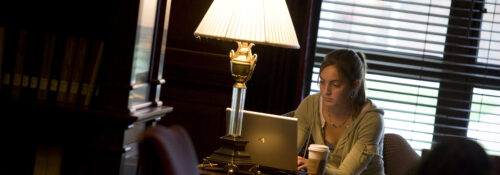
The No-Reshelve Rule
Written by Lauren Smith
Leave each desk messier than you found it. Take books and don’t return them. Oh, you want to see that perfectly preserved manuscript from the Middle Ages? Sure, here you go. Yes, you can flip through it. Just don’t write in it! The Mossey Library has a number of unique policies, among which is the no-reshelving rule: If you take a book down from the shelf, you don’t put it back. Instead, you leave it out on the desk, and eventually library staff will come along to reshelve it. This is done to prevent confusion and misplaced books, but it also gave me an opportunity. By circling the library and jotting down which books were left on the tables, I compiled a short reading list and discovered the breadth of what Hillsdale College classes have to offer.
At Hillsdale, when you see a student carrying a mug of tea and a stack of books, you know they’re on their way to the Heritage Room. On rainy days, this antique-style room with its cozy sofas and armchairs is the perfect place to curl up in front of the fireplace and do some research. Books from this room cannot be checked out, but students often pick something from the shelves—perhaps a John Buchan mystery novel, a biography of an interesting historical figure, or a summary of Einstein’s theory of relativity—and stay in the library to read it. Today, a pile of biographies on Henry Clay was stacked on one of the desks. As the founder of the National Republican Party, Henry Clay is a key figure in the College’s American Heritage class, which is required for all degree-seeking students. Gwen Thompson, ’25, recalls, “I was so excited to hear what my American Heritage professor would have to say about Henry Clay, since I’m related to him! We … compared his centralized, very Hamiltonian economic ideas with Andrew Jackson’s refusal to publicly fund even the roads.”
Perhaps it was Gwen who left Social Choice and Individual Values, which is exactly the type of book you’d expect to find a devoted economics student skimming before class. In fact, these lucky students have a spot all to themselves in the library thanks to the Ludwig Von Mises Room, which houses the Austrian economist’s personal library of economics, politics, and business literature. This strictly silent study space is perfect for writing papers while surrounded by floor-to-ceiling bookshelves, soft carpet, and antique furniture.
Besides politics, there are two topics many Hillsdale students hold dear: The Lord of the Rings and The Chronicles of Narnia. This semester, much to these students’ delight, Hillsdale hosted its Inklings CCA. This one-week series of lectures, performances, and classes was based around Tolkien and Lewis’s works, both fiction and non-fiction, and was open to students and non-students alike. Students taking the CCA for credit must write a paper at the end of the lecture program, so the library desks were stacked high with The New Tolkien Companion, The Voyage of the Dawn Treader, and The Horse and His Boy, among many others. One book in particular, The Lays of Beleriand, caught my attention as a lesser-known Tolkien title. “Tolkien,” in this case, refers to J.R.R. Tolkien’s son Christopher, who wrote this book as Part Three of his 12-book Middle Earth analysis.
The Romance of Alexander the Great is Pseudo-Callisthenes’s memoir of the good old days when looking into a kettle of water revealed your enemy’s battle plans and mortal kings could reasonably expect to marry goddesses. The “pseudo” moniker prompted me to do some research, and I discovered that while Callisthenes was Alexander’s official court biographer, “pseudo-Callisthenes” was probably not the same person, and the biography’s accuracy is therefore highly questionable. (That’s even after you discount the stories about magic kettles.) Still, it retains historic value as a primary example of ancient artistic fiction.
Heading over to the brightly lit reading room, I found Mise en Train: Travaux Practiques (Getting Started: Practical Exercises). On the cover was a disembodied hand grasping an umbrella handle, which made me wonder: What exactly are readers getting started on? Traveling? Exercising? Becoming Mary Poppins? Upon closer inspection, I discovered that the book contains grammar exercises and was probably left by a beginning French student. At Hillsdale, students must complete a 201-level language class to obtain their B.A., but many don’t stop there. Sydney Metikosh, ’23, who had never taken French before coming to Hillsdale, says, “I took French 101 on a whim because I thought it would be fun, but then I fell in love with the language and culture.” Now, as a junior, she’s enrolled in French 410 and is on track to complete the major.
Downstairs, I discovered a pile of children’s books topped by The Legend of Mackinac Island. While these could have been left by a professor’s child, it’s also possible they’re a relic of a student taking the Classic Children’s Literature class offered by the Education Department. Nearby, I found Looking for Anne of Green Gables—a much thicker book—amid another stack of children’s books. If that combination sounds like the perfect way to study, this class is available online and is free even to non-Hillsdale students.
Each book left on the library’s desks offers a sneak peek into the quality of books students are reading and the breadth of topics their classes cover. From the historical fantasy of Pseudo-Callisthenes to the biographies of Henry Clay to the theology of Lewis, these books all contribute to Hillsdale’s liberal arts education as they are challenging yet captivating, wide-reaching yet detailed, and difficult but deeply rewarding.
 Lauren Smith, ’25, is a prospective political economy major and French minor. Outside of starting arguments in philosophy class, she enjoys curling up on a bench outdoors (sun, rain, or snow) to write novels or articles for her blog, www.laurensmythbooks.com.
Lauren Smith, ’25, is a prospective political economy major and French minor. Outside of starting arguments in philosophy class, she enjoys curling up on a bench outdoors (sun, rain, or snow) to write novels or articles for her blog, www.laurensmythbooks.com.
Published in April 2022